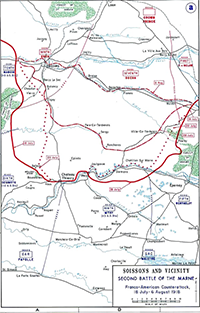The 1918 Allied Counteroffensives
The Second Battle of the Marne was a victory for Allied forces over Germany on the Western Front during World War I and part of an overall counteroffensive strategy that reversed German gains in spring 1918. The German Army had launched a series of offensives in March 1918, driving strongly through a series of gaps in the line and coming as close to Paris as they had in the early days of the war, when Allied forces triumphed in the First Battle of the Marne. Those had ended in June. Another German attack, on the Marne, began the following month. 
The German high command still wanted to achieve a decisive defeat of the British Expeditionary Force in Flanders. As a means of diversion, German commanders ordered an attack further south, on Allied forces in the area of the Marne River, as a means of drawing Flanders-area Allied troops south as well. The attack began in mid-July, with a sharp advance in and around Reims. Whatever moderate success the German forces had secured ended two days later, as Allied forces had been swelled by reinforcements from the United States, which had declared war on Germany only the year before. Fighting as well in this counteroffensive were troops from Italy. Allied forces then mounted a counterattack, which included the pivotal Battle of Soissons. French forces there disrupted German supply lines and pushed the German attackers backward. By early August, Allied forces reversed the progress that the German forces had made during their Spring Offensives. The Allied side had suffered large amounts of casualties but had many more men and weapons waiting in the wings. The German side, too, had suffered large amounts of casualties but had dwindling resources on which to draw. |
|
Social Studies for Kids
copyright 2002–2026
David White




